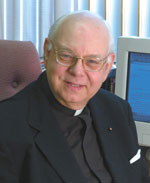Fourth Sunday of Easter /
Msgr. Owen F. Campion
The Sunday Readings
 The first reading this weekend is from the Acts of the Apostles. Acts is fascinating. It reveals the priorities and beliefs of the first Christians.
The first reading this weekend is from the Acts of the Apostles. Acts is fascinating. It reveals the priorities and beliefs of the first Christians.
The setting is Jerusalem. A Christian community has formed, very visibly and deliberately clustered around St. Peter and the other Apostles. Prayer, total devotion to the Lord, great charity and a sense of unity characterize this community.
Also vital to the community is its solemn responsibility to make Jesus known far beyond the circle of believers.
In this reading, Peter gives testimony about his faith before Jewish officials. He speaks for all the other Apostles and indeed for the community itself. Peter obviously is the unchallenged leader of the Christians.
Acts says that Peter was “filled with the Holy Spirit” (Acts 4:8). Peter was speaking in and with the power and grace of God. He emphasized that in healing a cripple, recalled earlier in Acts, he acted with the healing power of Jesus.
In his testimony, Peter insisted that salvation is not possible without Jesus because God gave Jesus to the world as its Redeemer.
The First Epistle of St. John is the next reading.
The three epistles, attributed to John, all have an eloquence and depth that is most appealing. The passage offered in this reading in fact is rather brief, only two verses, but it nonetheless is most expressive, a reassuring declaration of the theological fact that believers are nothing less than God’s beloved children.
The imagery is strong. No other human relationship so directly and well conveys the notion of love, caring, and life giving than that of a parent and child.
This reading also says that those who are worthy of being God’s children one day will see God and will be with him.
St. John’s Gospel supplies the last reading. It is a glorious revelation about the Lord Jesus. Everyone at the time knew what herding sheep was all about. Roman Palestine was by and large an agricultural nation. Sheep-herding was a major part of its economy.
The image of sheep is important. Sheep are gentle animals, vegetarian and not at all aggressive. They also are quite vulnerable. Predators easily make sheep their prey. Aggressors hunt for them, particularly the weak, young and unhealthy. Unable because of their placid nature to fight for their lives, sheep very much need their shepherds. Good shepherds care for the sheep, helping them to overcome the vulnerability created by their meekness and lack of cunning.
Jesus, in this passage, compares us humans to sheep.
Reflection
Jesus on several occasions in the Gospel compares humans and sheep. The likeness is a fact, but a fact that humans prefer to forget. We are vulnerable. We need a shepherd. Jesus is the good shepherd. He lays down life itself for us. He wishes that none of us be lost.
He is the Good Shepherd. It is an image that has survived the cultural transition in much of the world from the agrarian to the technological.
This weekend’s liturgy builds on this image, presenting it in this marvelous reading from St. John’s Gospel. When the superb literary technique of this Gospel is added to the process, the image is stunning and beckoning in its brilliance. Its meaning is clear because of the frankness of the Gospel.
It is vital that believers, indeed all people, realize that humans are very much like sheep. In so many ways, humans are at risk. Our instincts do not always serve us well. Sin threatens our eternal lives.
Jesus is the Good Shepherd that supplies all that we lack. He defends us against peril. He leads us to safety. In Jesus alone is life, as Peter proclaimed. †
 The first reading this weekend is from the Acts of the Apostles. Acts is fascinating. It reveals the priorities and beliefs of the first Christians.
The first reading this weekend is from the Acts of the Apostles. Acts is fascinating. It reveals the priorities and beliefs of the first Christians.